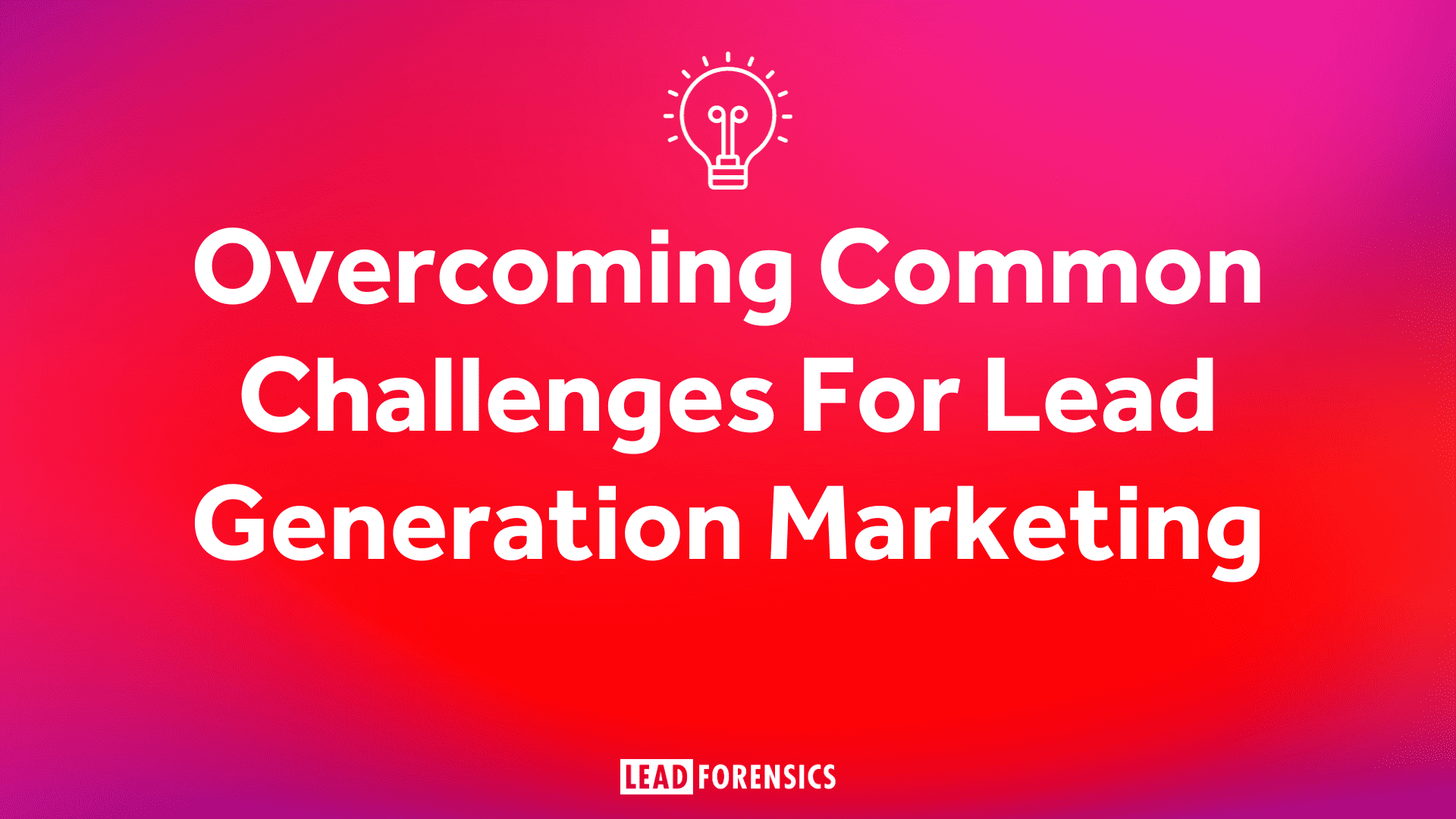Lead generation marketing is a vital process; identifying potential clients who fit your target audience and have an interest in purchasing your product through marketing channels is a strategy organizations everywhere take action on daily.
Getting the right attention
The needs and preferences of our buyers are ever-changing. They consistently evolve depending upon current industry trends and business news, which makes creating an outbound lead generation marketing strategy that keeps up a true challenge.
To combat this, some marketing teams aim to use commonly favored methods known to bring blanket success, putting out offers that attract many, and using strategies that have proven popular for other businesses. The problem is, one size doesn’t fit all, and whilst these options may produce more leads in quantity, their quality will be so low, they’ll be useless to your business. If they’re not from the right industries, and don’t match vital ideal buyer criteria, there was no point generating that lead at all.
To truly overcome this challenge, you need to identify your target audience. Ask what elements make this audience a perfect match for your business; is it their industry or a specific action or process they undertake? These details help you analyze how these buyers conduct a purchasing journey and what steps they go through, to better create a lead generation strategy meeting their needs.
Managing warm leads
Leads don’t always convert first time. Many marketers gather data for those who have an interest in their product, but haven’t identified enough need to inquire, nurturing these contacts until they’re ready to convert. However, understanding warm lead engagement levels, and when best to send relevant content and communications, is a challenge for many businesses.
If this is a challenge for your team, try initiating a lead scoring model with the help of a tool like HubSpot. Assigning a score to leads as they continually engage with your brand makes contacts easy to manage, signaling when they’re ready for your sales team to contact. It also ensures lead quality remains high, as scores can increase based on the essential lead criteria you outlined in target audience identification.
Mastering lead response time
An equal number of marketing departments also confess a struggle in responding to lead engagement and interest in a timely and effective fashion. Many studies have proven the importance of instant lead response; contacting leads within five minutes of showing engagement makes you 4000% more likely to enter them into your pipeline. This is a common challenge for many however, as only 37% of teams were able to contact leads within the first hour, proving just how many are missing out on the huge benefits gained by instant lead response.
Addressing your KPIs is a great place to start when looking to improve lead response time; set a KPI of 10 minutes between gaining a new lead and making initial contact, ensuring all processes needed to qualify and cleanse lead data can be operated in that short time. If it’s just not doable, these processes need to be streamlined. If the time delay comes from identifying leads generated, a new way of gathering lead data needs to be proposed. This focus on a 10 minute window for lead contact helps your team understand and overcome any obstacles.
Measuring lead generation success
Whilst 80% of B2B marketers claim to be driven by data, a third of marketers admit to struggling when measuring lead generation success, choosing the right metrics to monitor and analyze. It’s a known fact that attributing lead generation results for ROI is difficult, and without a multi-touch approach, this will remain a consistent challenge; but measuring lead generation doesn’t have to be so testing.
Working through each channel to understand what campaign elements need measuring to understand problems and make improvements is a great place to start. If a measurement doesn’t provide information your team can use to action changes for increased success, then there’s no need to measure it. Don’t forget to also look to your entire pipeline, measuring the quality of leads generated based on their sales success. Gather all this data together to gain a holistic picture of lead generation success, from initial marketing outreach to the final sale.
Working with the right team
Currently 4 in 10 managers feel they’re struggling to build a team properly comfortable with lead generation processes. No matter how good your strategy plans are, if your team is unable to properly execute them, or commit to persevering through difficult slumps, your business results will suffer. The challenge of working with the right (and best) lead generation team appears in two key ways.
Firstly, some teams struggle with a stretched workforce; too few in numbers, each team member must take time away from focusing on lead generation to undertake additional tasks such as data collection and organization, reporting and strategy analysis. This starts a vicious circle, whereby your team are too stretched to gain a bounty of new leads for your business, stifling revenue gained and business growth, meaning your team are unable to recruit for additional members to share the work load.
Some teams also struggle to recruit those with the right skills to run more intricate campaigns; someone experienced in email marketing would struggle to properly manage an SEO strategy or PPC advert. Building a strong lead generation team with all the skills needed to manage a variety of campaigns proves difficult for many.
Whilst recruitment can be difficult, this challenge can be improved by re-addressing your employee break-down, and looking to recruit a team based on their pipeline position. Having teams focused solely on outreach, data processing and reporting, conversion and lead response ensures all the essential elements of lead generation are followed through to completion, without your team taking on too many varying tasks. Consider also to recruiting remote workers when struggling to find specific talents. Those working from home can be more productive than those working in offices, and if you’ve not yet found an SEO expert, this may be the key to building your dream team.
Maximizing on budget
25% of B2B marketers struggle to maximize on their lead generation budgets, finding the best ways to utilise funds and make the maximum return. Striking a delicate balance when running an effective campaign between producing lead quality and quantity is no easy feat. This is why many lead generation solutions offer a free demonstration or trial period, so your team can properly understand how this new tool will boost your lead generation strategy, whilst ensuring you’ll gain a stable return for your business investment.
For example, at Lead Forensics we identify your business website visitors and provide contact details for their key decision makers, for instant impactful follow up. We want you to be 100% sure in the solution you’re purchasing, so you can maximize your lead generation budget and gain an outstanding return on investment; some of clients have seen ROI in excess of 2,100%! Find out more- book your free demo today!
Implementing systems and sticking to plan
A winning lead generation marketing strategy is intricately planned out; you’re sure to set up the appropriate reports for measurement, implement all necessary software solutions needed and map out each planned campaign. However, recent studies show a high amount of marketing teams struggling to follow these plans through to the end, often diverting from the ideal and losing valuable results due to swaying off track.
This is a challenge only you can identify, and only you can overcome- no amount of outside help will ensure you stick to the plans you outlined. So be realistic in planning, ensuring you reflect any details you know may change or jeopardize these plans later. If you always end up needing additional campaigns to gain last minute results in quarter three, then incorporate them as part of your strategy. If your December results are always low, plan around this and ask where you’ll make the numbers up.
Producing relevant content
Content continues to pose a challenge for lead generation strategies everywhere; effective assets nurture your leads to produce high-quality new business opportunities that make bigger and better sales, but mastering the art of producing consistently relevant and engaging content is difficult. This challenge is consistent as buyer’s needs and current news is ever-changing, but gaining insight into your online audience and the current content subjects and formats they download is a great starting point.
Using lead generation software like Lead Forensics can help your team identify the businesses visiting your website, offering an insightful window into your current online audience. With a detailed profile of every website journey, you can easily understand which content converts your target audience, what pain-points they need information for and what news entices them. This doesn’t just improve your lead generation efforts, it helps you create relevant content your audience will love. Find out more- book your free demo today!







